Table of Contents
Points Miles and Bling (blog) contains referral or affiliate links. The blog receives a small commission at no additional cost to you. Thank you for your continued support. Credit Card issuers are not responsible for maintaining or monitoring the accuracy of information on this website. For full details, current product information, and Terms and Conditions, click the link included.
The Great Migration – one of nature’s greatest spectacles – involves the annual movement of millions of wildebeest from the plains of the Serengeti to the Masai Mara. This experience has been a bucket list item for me ever since I knew what a bucket list was. While there are so many different kinds of safari experiences to be had in Africa, there was little doubt in my mind that I wanted my first to be of the ‘classic’ African Safari variety – during a time when I could try and catch this extraordinary natural wonder. Finally, a little over a year ago, I had the chance to go on this unforgettable and awe-inspiring journey, and it truly surpassed any expectations that had built up inside my head over the years.
Making the experience all the more memorable was that what I initially intended to be a honeymoon trip became a wonderful family vacation with 13 other adult family members. Though a safari honeymoon would have been incredible, I thought that being able to go on this kind of trip with so many family members would truly be a memorable, once-in-a-lifetime experience.
I’ll write a short series on the planning process and experience – not because I’ve suddenly become an expert on the topic after a solitary trip – but rather to share what I learned while researching and planning this group trip to Africa. I hope to share tips that can help guide your plans for either a Safari or just simply a large group trip somewhere. Pre-trip research can be challenging for a safari adventure – too many people only ever go on a solitary trip and don’t have much to compare their experiences with, so the usual first-hand reviews aren’t as reliable as you would normally find. Another factor muddying the waters is that there are many blog posts reviewing safari lodges, which are not very transparent in the sponsored nature of their posts. This is just something to be aware of as you embark on selecting your lodge amongst the hundreds of options you’ll find across the continent.
Let me get something out of the way – group travel planning is NOT easy—end of story. Planning an overseas trip to any destination is hard enough when you are juggling 14 work schedules with 14 sets of preferences and priorities – add in an expensive trip to a distant destination – with the tightest of schedule flexibility and then having everyone agree to the same itinerary and budget – suddenly makes this challenge a lot harder. The trip overall was rewarding in so many different ways, but at times, it certainly had its challenges.
What is The Great Migration?
The Great Wildebeest Migration, or the Great Migration as it is often referred to, is the annual migration of over two million wildebeest, zebras and gazelles as they move through the Serengeti and Masai Mara in search of grazing lands. This cyclical journey across Northern Tanzania and Kenya is the largest animal migration in the world and one of nature’s great wonders. Aside from the sheer spectacle of seeing this moving muscle mass in unison, the migrating herds are closely followed by Africa’s most prolific hunters. From the giant crocodiles of the Mara and Grumeti rivers to territorial packs of hyenas and lion pride to the more reclusive leopards and cheetahs – everyone’s looking for their pound of flesh (quite literally) when the migrating herds pass through their turf.
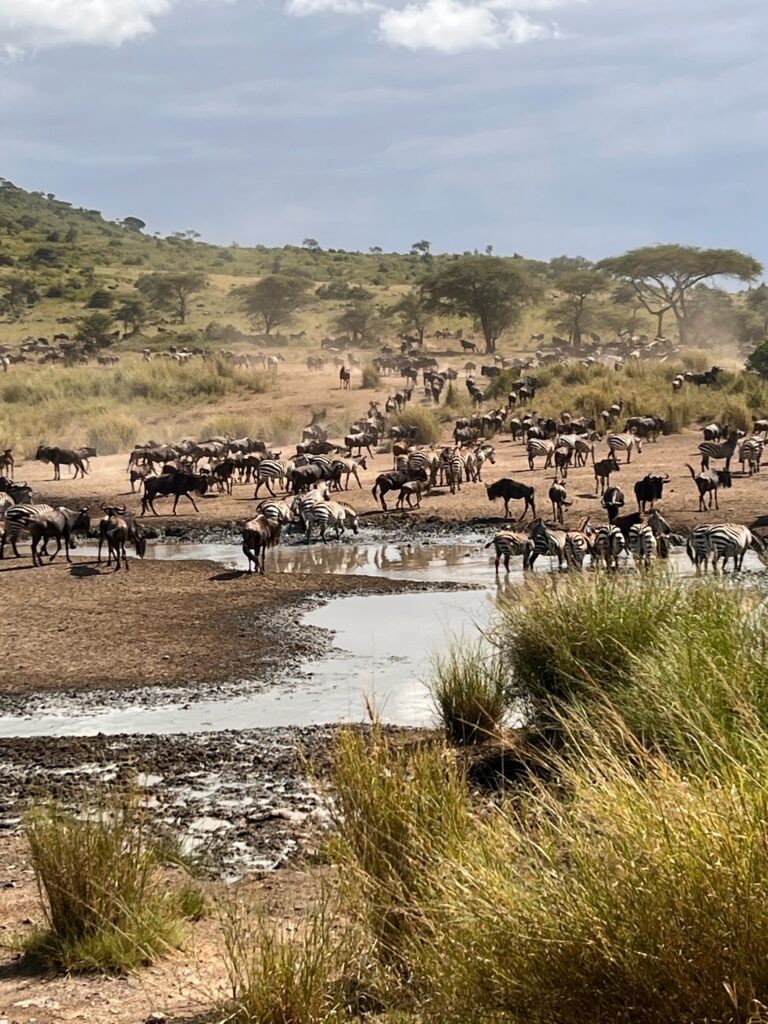
Where should you go for a Safari?
This is probably the first question that needs answering. Regretfully (and thankfully!), there are plenty of options and no right answer. The first countries that probably come to mind would include Tanzania, Kenya and South Africa – however, Eastern and Southern Africa have plenty of options that first-time safari-goers probably would not think of, such as Namibia, Uganda, Botswana, Rwanda, Malawi, Zambia, Zimbabwe to name some. Any of these would be worthy options for your first experience. Each of these destinations provides truly unique experiences, from trekking with Mountain Gorilla in the Rwandan and Ugandan jungles to the Etoshi National Park safari and the Kalahari Desert in Namibia. There is no wrong choice of where you end up going.
Notwithstanding that – if you’re like me – the notion of the classic African Safari that most people imagine will likely be found on the plains of the Serengeti and neighbouring Masai Mara. Between the two parks, the migrating herds spend most of the year in the Serengeti in Tanzania, with just a brief window where they cross into the Masai Mara National Reserve in Kenya.
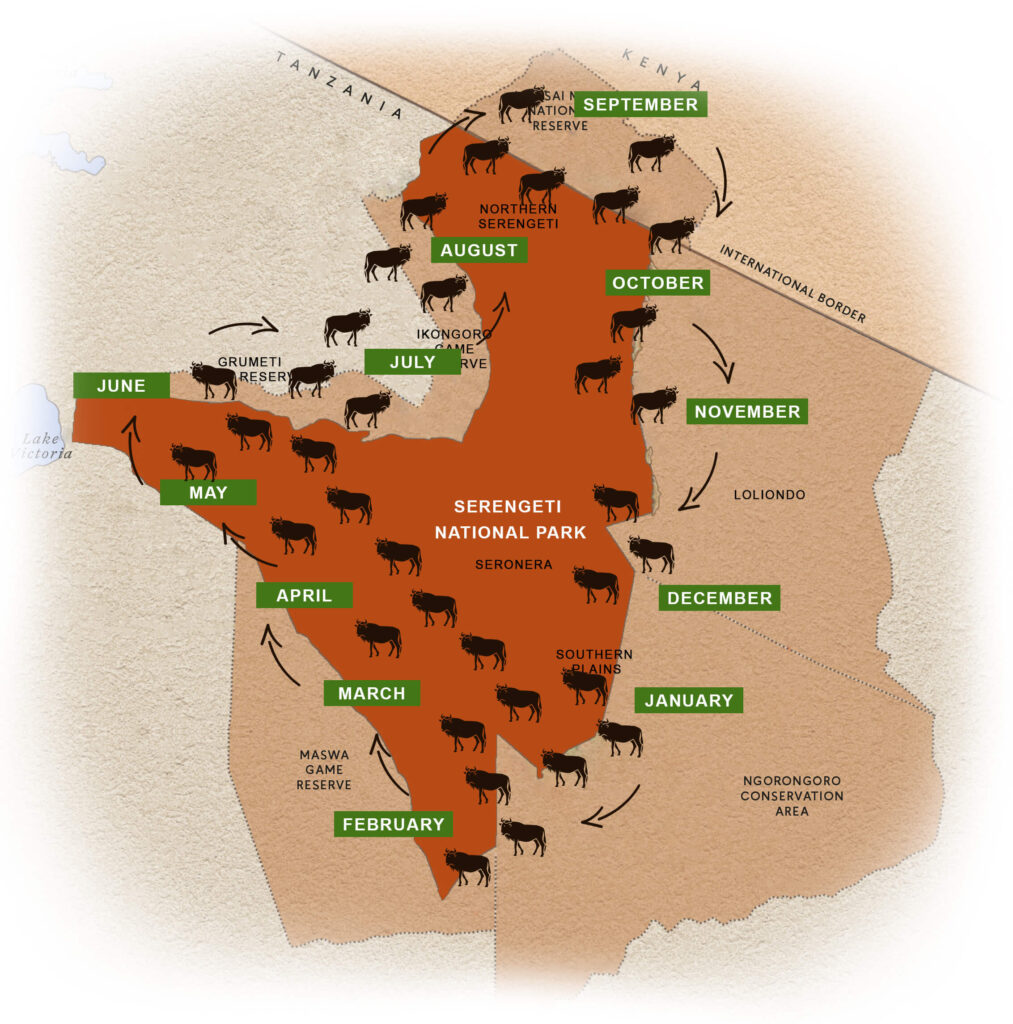
The Great Migration – seasonal migration patterns (source: whileinafrirca.com)
What time of year should you go?
I don’t think it would be inaccurate to say that many people don’t realize that the Great Migration is a year-round event – so inherently, the answer to the question “what time of year can I see the Great Migration?” is all year round. The question is, what time of year can you see it in a specific region and what migration stage happens when.
What most people probably envision when they hear Great Migration is the spectacle that is the river crossings, which you’ve probably seen on countless nature documentaries. To maximize your chance of viewing these, you’ll want to pick a time of year when the herds will be in the northwestern corridor of the park near the Grumeti and Mara rivers (labelled June-July-August in the map above). The first crossings could start as early as the end of May, but usually in June, when the Grumeti river crossings happen, followed by the Mara river crossings that typically occur in September.
The challenge with trying to time these events is that weather patterns – specifically rain and water levels – largely dictate when these occur. It’s also no surprise that the river crossings, along with the accompanying onset of warmer/dryer weather, result in most tour operators switching to peak/ high season pricing, usually in the very first few days of June. Loosely speaking, June- October is usually dryer and warmer, with a short rainy season beginning in November, followed by a more prominent rainy season into March and April.
Following a short rain season in November and December, the herds tend to arrive on the southern plains of the Serengeti in January and stay in this part of the park mostly through March. The calving season occurs during February when approximately 8,000 calves are born daily and duly attract a high concentration of predators looking for an easy meal.
Aside from the famed river crossings, the calving season was something that I was very interested in as well. This happens during a brief window during February when the herds are in the southern portion of the park around the Ndutu area (labelled February in the map above). In April and May, the herds begin to make their way north again in search of fresh grasslands and water. For a more illustrative guide on herd movements, check out this page from whileinafrica.com.
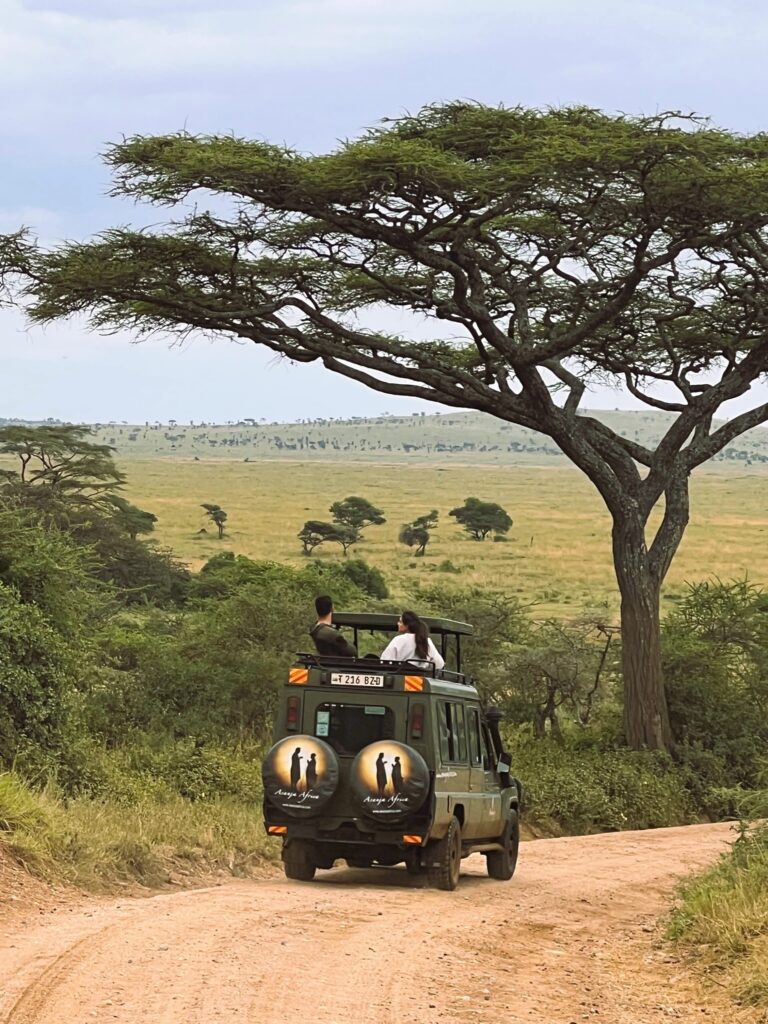
How should I begin planning for my first safari?
A Safari adventure will likely require a sizable investment of time and money, so you’ll be motivated to start your research early. The internet is going to be your best port of call to start doing some preliminary research to help you think about the most basic questions (like the ones posed in this post). You don’t need to have answers to all the questions from your initial online research alone – but at least it gets you thinking about some key considerations that will form the basis of your trip (i.e. time of year, country, any must-see or must-do experiences that you want etc.).
Once you’ve had a chance to do some early research and to think over some of the more important questions – I would highly recommend seeking out an experienced operator/travel agent who specializes in Safari in Africa (i.e. not your standard issue Virtuoso or Prive travel agent). Agents specializing in safaris tend to have years of experience organizing, scouting and visiting the many operators they deal with. Thus, they have first-hand knowledge and direct contact with the properties. Just as importantly, they can give you incredibly valuable insight as to particular locations of camps and lodges and what sort of game can be found in that region during different times of the year and are able to provide first-hand comparisons between camps and lodges that they may have visited.
When starting, I contacted a couple of tour operators and asked for proposed itineraries for the dates and type of safaris I was looking for. Most of the initial responses were typically introductory emails where they asked for more specific questions while providing a sample itinerary and some price quotes as a starting point. I had planned to try and connect with 1-3 North American-based travel agents to (i) get a gauge of the service I can expect during the planning stage, (ii) have a contact point located in a relatively similar time zone to get prompt responses to queries and (iii) I thought it would be a greater chance that a North American based operator would accept credit card payment as options.
I liked The Safari Partners – a small travel agency based in Vancouver. From my early emails exchanged with Chris Ronneseth, the founder of the Agency, it was clear that he had a ton of first-hand experience with the continent. Throughout planning the trip, I had several phone calls with Chris where he answered all my questions – from simple ones like explaining the realities of trying to catch the Great Migration to some insight about the lodging options that were on offer – down to his suggestions on how to manage the itinerary – Chris was incredible! A no-nonsense, non-sale-sy personality – his vast knowledge of the continent shone through. This was no bells and whistles travel agency with a cringe name and a social media account – nope, this was exactly what I needed as a first-time safari planner on whom others depended on organizing a memorable experience.
Over a few months, we went through multiple iterations of planning – from moving dates around to brainstorming on the perfect lodges -the contributions of Chris and his colleague Jennifer were immense. Once the itinerary had been finalized and the deposits made, The Safari Partners organized the airport pickups, the domestic flights to the airstrip, as well as our flights back to Zanzibar.
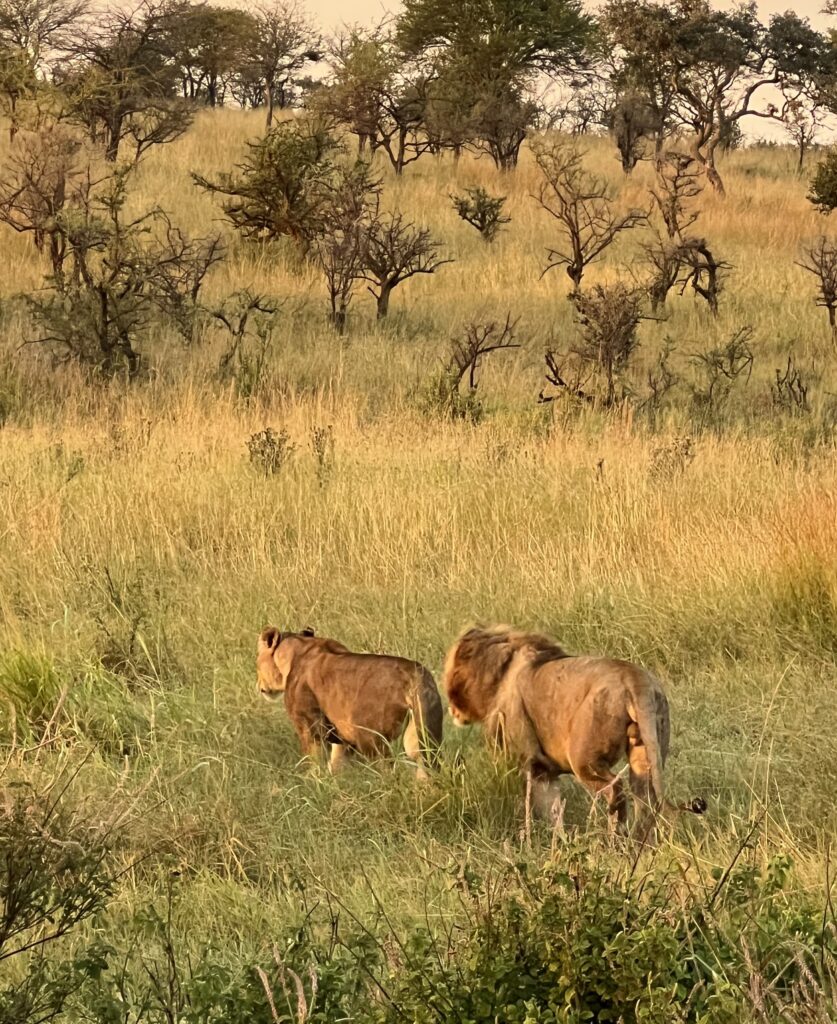
2 of the 4 lions were probably within a km radius of our lodging.
Overall – working with The Safari Partners gave me a lot of peace of mind ahead of embarking on the trip. I wouldn’t say this step is required – but I do think it is vital for making a good informed decision, especially if you’ll be travelling in a large group and don’t want to make the mistake of booking yourself in a part of the park that s not ideally located relative to prime wildlife viewing areas.
What country did I pick?
I had two clear needs to work around when coming up with the initial itinerary.
- Firstly, the only windows that worked for the group were the end of May into early June, and
- Secondly, I wanted to maximize our chances of catching a glimpse of the Great Migration.
With these two requirements, Tanzania quickly became the obvious choice as we would be making it just in time for the end of the shoulder season, with a better than 50-50 chance of catching the migration in the Western Serengeti corridor as historically that is where the herds have been in during this time of year. That was a chance I was willing to take, however, given the combination of the tight dates, the more attractive shoulder season pricing and after being assured that migrating herds or not – the wildlife viewing would still be excellent.
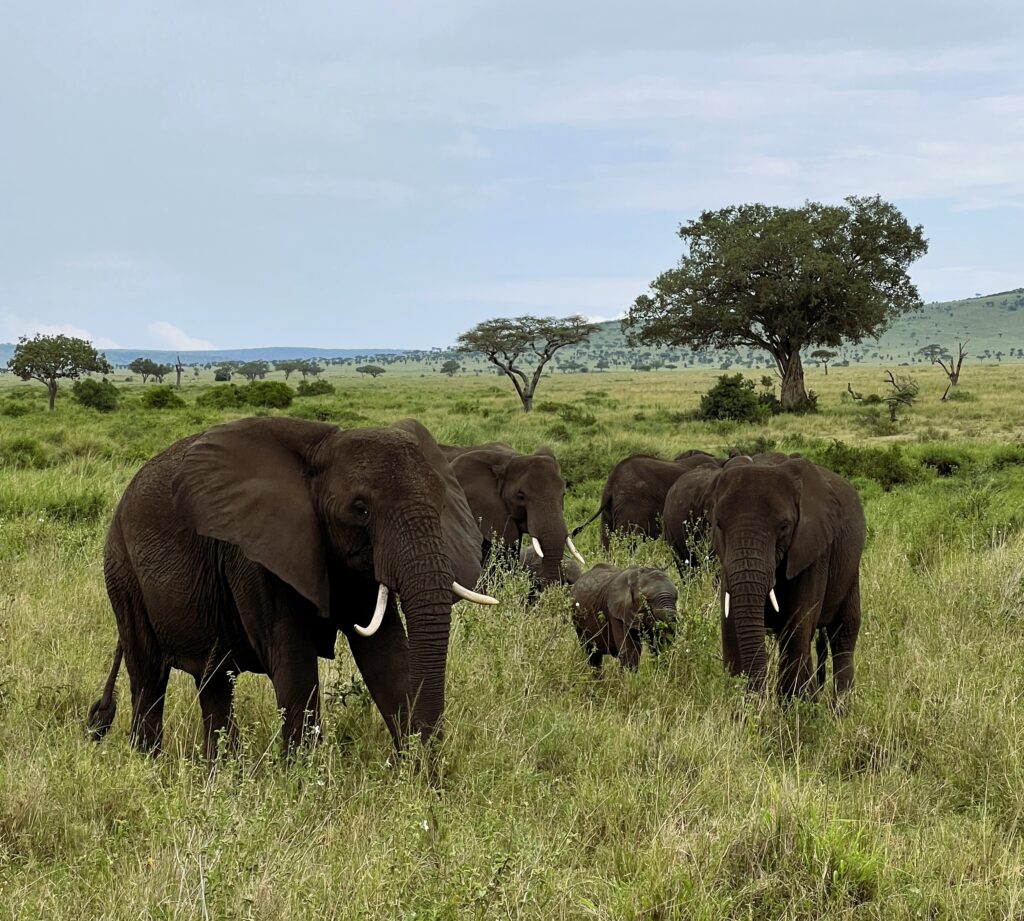
On the last point – it’s important to note that a safari in the Serengeti or Masai Mara will still be an incredible experience even if the migrating herds are not passing through, as they all have their ‘resident’ population of animals. Certain parts of the park – for example, the Eastern Serengeti – are excellent viewing regions for the big cats. Visitors here will still get wonderful safaris with lots of animal viewing, even at a time of year when the migrating herds will not be around.
Tanzania’s National Parks and which one’s to see?
In an ideal world, I would want to see every one of them – but alas, we live in a world far from ideal. So what to do? Tanzania has several world-class National Parks, with the Serengeti probably being the most famous. Situated in Northern Tanzania, there are several other well-reputed National Parks close by.
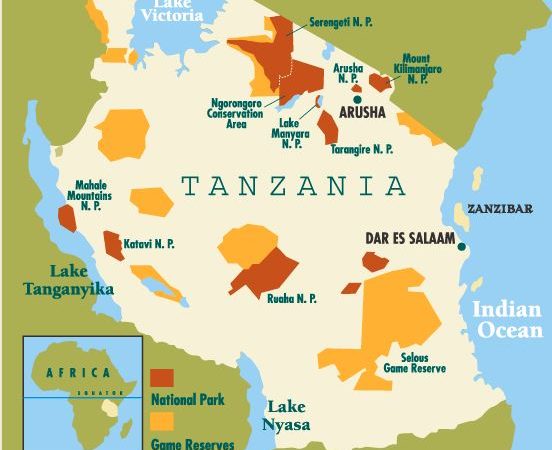
Arusha National Park, Kilimanjaro National Park, Lake Manyara National Park, Tarangire National Park, Ngorongoro Conservation Area, and the Serengeti are popular stops during a typical African Safari in Northern Tanzania.
When searching for safari itineraries, it’s expected that most operators will propose one which includes driving through multiple parks. I’ll discuss this more in the below section – but for now, my thoughts on this question are that it depends on the trip. There are situations where visiting multiple parks might make sense, but what if you need to only pick one or two? Which ones stand out? For me, this is an obvious answer. The Serengeti and Ngorongoro crater stand head and shoulders above the neighboring parks as a final ultimate destination.
While the Serengeti is the largest of the surrounding parks and boasts an incredible biodiversity of animals – as well as playing host to the Great Migration, the Ngorongoro Conservation Area also offers a unique and spectacular experience. Located in a crater formed by a gigantic volcanic eruption, the park is a self-contained ecosystem with one of the largest concentrations of resident animals in Africa. All of the ‘big 5’ can be spotted within the crater (including the Black Rhino), and the animals here are well accustomed to safari vehicles, making viewing and spotting animals very easy. The ideal times to visit would be starting in June when the rainy season has dissipated, and the high season crowds have not come in yet (which usually begins in July). It’s worth noting that the migrating herds do not pass by the crater.
Should we do a Fly-in/Fly-out Safari?
You have two options for the kind of safari you can do. A fly-in/fly-out would typically mean flying from Arusha into one of the airstrips in the National Park. From there, you would be picked up by your safari lodge and driven straight to your lodging with a game drive.
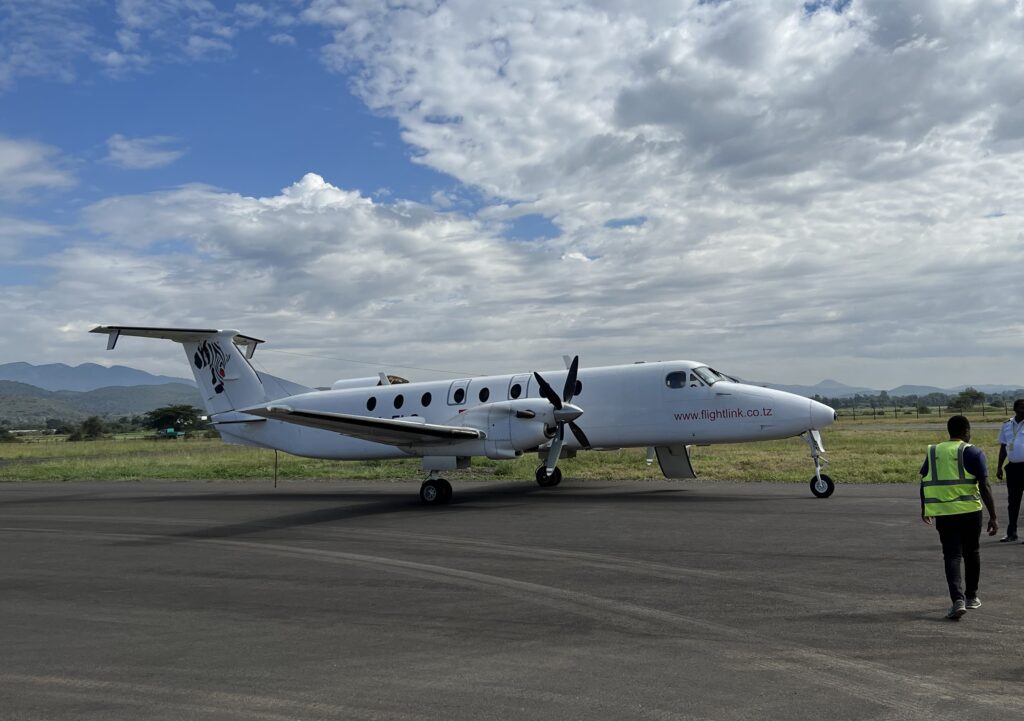
Catching our plane to the Seronora Airstrip in the Serengeti
The other option usually entails leaving Arusha by car and driving with your guides to your destination(s). You’re likely to do this in an itinerary where you are changing accommodations multiple nights during your trip and, along the way, are visiting multiple parks.
Some important considerations in deciding which type of trip you will take include the following:
- Additional Drive Time: The chief difference between the two options is drive time. Driving from Arusha to Manyara, Arusha, Tarangire, and Ngorongoro NPs en route to the Serengeti will add serious time drive time to your trip – with some legs exclusively taking up an entire day in your itinerary. The good news is that you can do some game drives on your way. However, the bad news is that you will have little flexibility in deciding your game drive. For example, say you are staying at Tarangire NP and in the morning of your departure to Ngorongoro, your guide hears chatter on the radio about a large Elephant herd passing through the Eastern part of the park – you won’t have the flexibility to adjust your plans and head there as it’ll be the opposite direction of your intended itinerary.
- Weather and Road Conditions: If you’re considering going during the rainy season or shoulder season, due to either timing constraints or more attractive pricing and fewer crowds – then just be aware that not only can rainfall be torrential during these times – but they can also wreak havoc on the road conditions.
Most roads within the park are dirt roads, so repeated rainfall can make some routes almost inaccessible. My advice is if going anytime outside of the dry season, try and do a fly-in/out safari plan with stays at 1-2 lodges at most – and pick your location in an area of the park where you can travel 360 degrees around. This is ideal if, for example, a certain region in one direction is experiencing heavy rainfall. Your guides can take you off in a different direction to a region that perhaps has not been impacted at all.
If doing a driving safari straight from Arusha through multiple parks during the rainy season, then be aware you are taking the risk of long journeys where rain and bad weather conditions could potentially present serious delays at best to your itinerary plans. - Local Guides: Probably the single most important thing that can make or break your safari experience are the guides that take you on the game drives. These are the guys and gals who’ll keep you entertained with all sorts of information on the wildlife and fauna you are viewing. Not only that, often they double up as the drivers as well (though some lodges provide dedicated trackers and guides on game drives). Generally speaking, you can hire your guides and cars from your point of origin, who will then stay with you and drive you through all the different lodges and parks that you are staying in. These guides are ‘generalists’ of sorts – while they may have vast knowledge of the wildlife – they may not have a high level of expertise in certain areas of the parks.
The flip side is guides who reside at the actual lodges themselves. These guides will tend to specialize in the region where the camp is situated, as well as have in-depth knowledge of the wildlife in this area (i.e. details of the lion pride, how many cheetahs are in the region, best viewing spots, etc.).
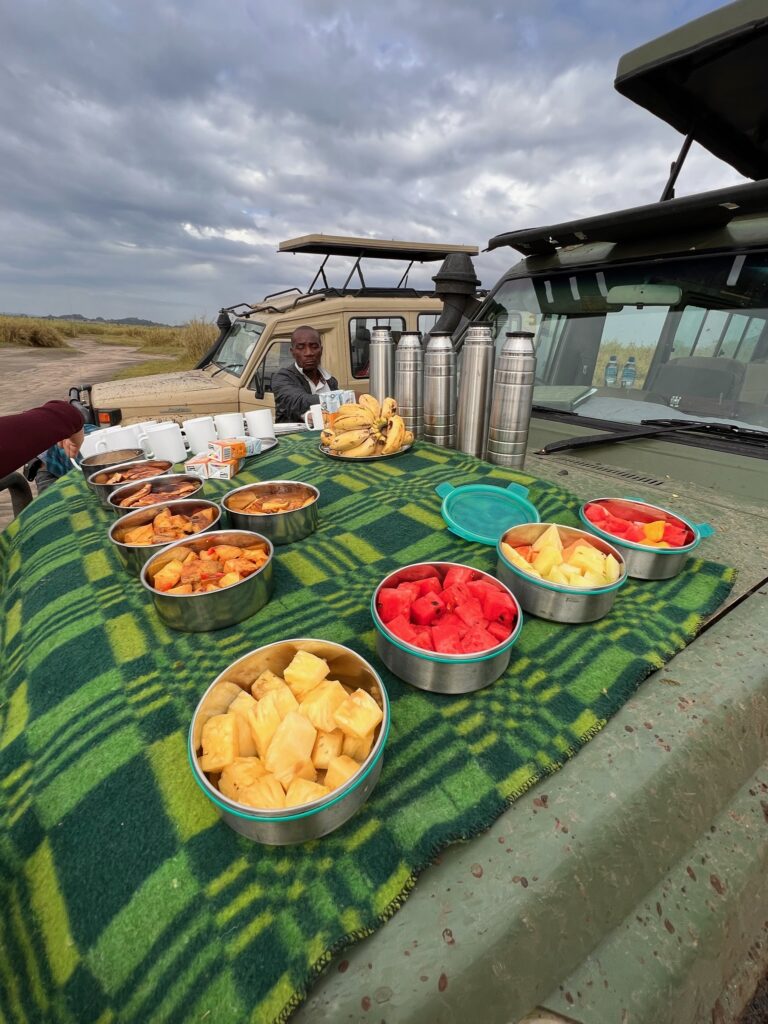
‘Bush Breakfast’ – one of many activities safari operators offer to keep your days fun
How long should I go for?
Frankly – I can’t relate to those who plan to go all the way to Africa to have a quick 3-night experience. As someone who could probably spend weeks on end on a safari trip – going for anything less than 5 nights has me questioning whether the effort is going to be worth it. Unless you are restrained by budget – I would have to say that 5 nights is an absolute minimum, with 7-10 a good amount of time for me, especially if you are planning on changing safari lodges in between.
I’ve heard some people say that 4-5 days was just enough time; otherwise, they would have risked getting bored – I again can’t relate to that. Remember that you are coming into nature, and nature is unpredictable. You will not see everything you want in one drive. You may get a few drives rained out if you take a chance and go during the rainy or shoulder season. You need to factor in driving times if you’re changing lodges, jetlag, or taking the odd slower day here and there by either enjoying your camp/lodge or perhaps enjoying one of many special activities that operators offer.
Of course, it is understandable if budgetary constraints or vacation days require you to keep your safari trip on the shorter end of the scale – then I would advocate that you do a fly-in/out safari and settle in on one lodge and avoid the unnecessary time spent commuting between multiple lodges.
Logistics of group booking payments
If there is one advice I can offer for any scenario where you manage a booking for a large group, then that will be to be clear and upfront about payment deadlines. Always give yourself some extra time and buffer to collect payments before payment deadlines to vendors are due.
In group travel, where the overall number of guests could have cost implications of lodging rates/ group rates – be upfront and firm on things like non-refundable deposits after certain dates. I have done a couple of group trips now, both with family and friends, and being clear on the non-refundable nature of deposits and giving everyone ample notice for deposit dates has saved me a lot of heartache over the past few years.
Lastly – it goes without saying that if you’re dropping $40-$50K on a group travel booking, then make sure you exhaust all options about being able to leverage credit cards to make payments. In my example for the safari, there was a weird oddity that USD payment links for our travel agent would not accept Amex, but the Canadian payment links would. So, always include this in your initial conversations with the tour operators before settling on one. In my case, I was able to get approved for a Spark Business Cash card on a special promo that awarded 250,000 Capital One Miles after spending $50,000 – a huge chunk of which I was able to clear via the deposits made for the bookings.
What did our trip look like?
Ultimately, for our trip, we booked the very last week of shoulder season (end of May) for a safari camp in the Serengeti, followed by a flight out with the family to Zanzibar, where we would all enjoy some R&R before people started to head back.
As much as I wanted to, I just couldn’t logistically fit in Ngorogoro for this trip. I had considered returning to Ngorongoro with my wife after Zanzibar, but it would have coincided with the beginning of Peak season. I wanted to avoid Ngorogoro during the peak season as, from many first-hand reports, the crater and road descending (all Ngorogoro-based lodges are up at the rim) can become heavily trafficked during busy days. Viewing spots can also get crowded- something that would no doubt take away from some of the magic of being in such a special place for me. After trying hard to work it into the plan, I had to give up on it and instead promised myself a future return to Ngorongoro during shoulder season to enjoy it in a calm setting.
I was particularly excited for the safari camp that we managed to secure as I had been looking for small operators that could accommodate all 14 of us and hoped that as we’d be occupying most of the capacity, we could have the entire place to ourselves – which is exactly how it played out.
So six nights were booked, all at the same camp, meaning no changing of accommodation would be required. Our camp was close to the Western Serengeti corridors and within driving distance to the Grumeti River, but was also very centrally located in the Moru Kopjes region in the Serengeti – famous for its unique rock formations, lion pride and as being home of the Black Rhino – allowing us to venture off into multiple directions for game drives should we need to avoid any inclement weather.
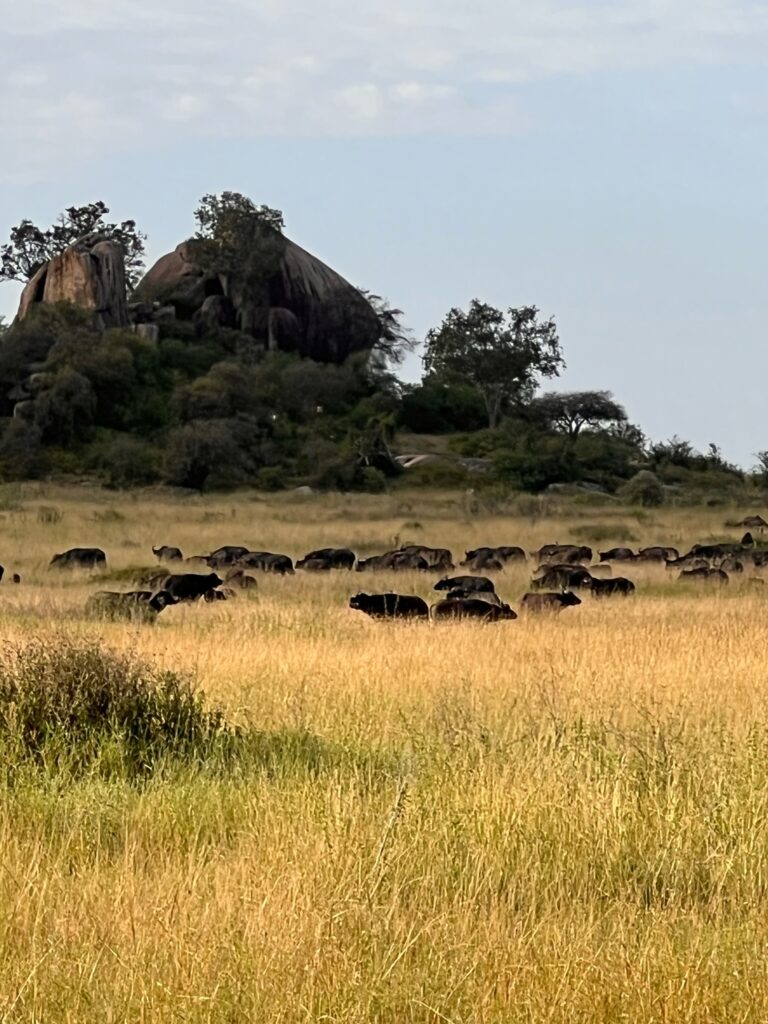
Moru Kopjes region
Final Word
Planning this trip was a huge and, at times, thankless task. Most people probably don’t understand and appreciate the time commitment necessary to organize a trip. Luckily, while it can be stressful at times, I enjoyed the planning part, and I’m thankful that we could pull something together and make it work.
Stay tuned for the next post, where we’ll get more into the details of what I booked, price points, other properties and operators that I had considered as well. I’ll also share some high-level thoughts on the JW Masai Mara, which recently has been a bit topical with the influencer crowd.
Until then, if you have any questions on safari, please comment below. Most might not know this, but Anshul is a treasure chest of information on the continent, as earlier in his career, he spent a lot of time there for work.
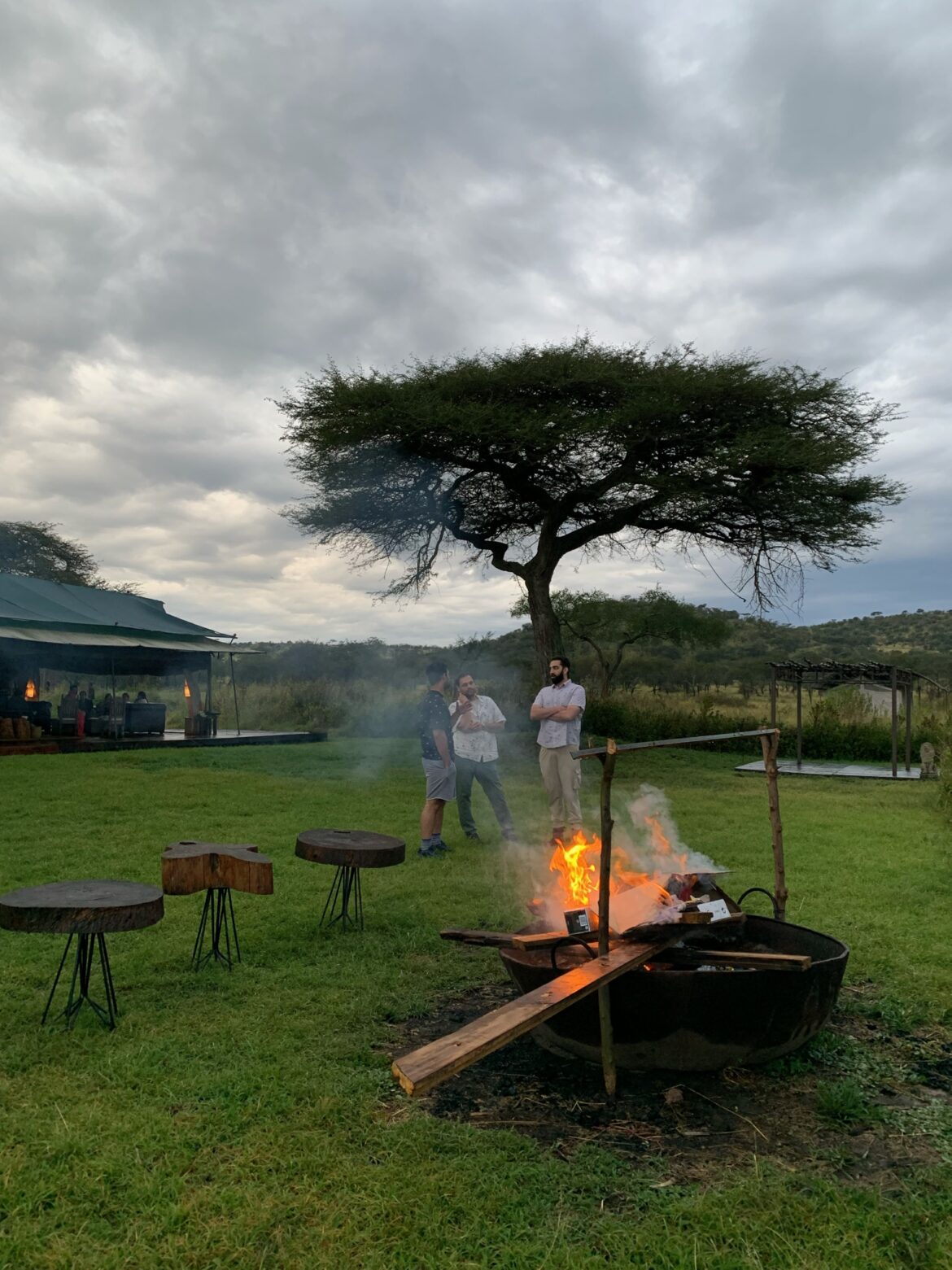
8 comments
perfect article thanks a lot
Thanks Mohammed – I really enjoyed reading this – extremely helpful to me to know where to start my planning
Awesome, been waiting for this review and the others to follow for a while
My bad – it’s been a long time coming! With the family growing by one, time (more attention span) has been at a premium – but hoping to catch up on my posts soon!
Very interesting, thanks!
Can’t wait to have your toughts about Massa Marai. I’m considering going next November.
Hi Pascale – thanks for your comment. Excited for you to go. I have been to the JW yet – but hope I can shed some perspective on what to expect/ how it might differ from some of the other options. Irrespective of that – I’m sure you’ll have a great time.
With no A/C or 5 star amenities, no Uncle Lee. 😅😅😅 Mr & Mrs Uncle Peach bruise easily.
Simple solution Uncle Lee – just go during shoulder season or off peak season. The temperatures during these season drop quite a bit during the night and early mornings and you’ll be more concerned about layering up then you will about wanting AC.